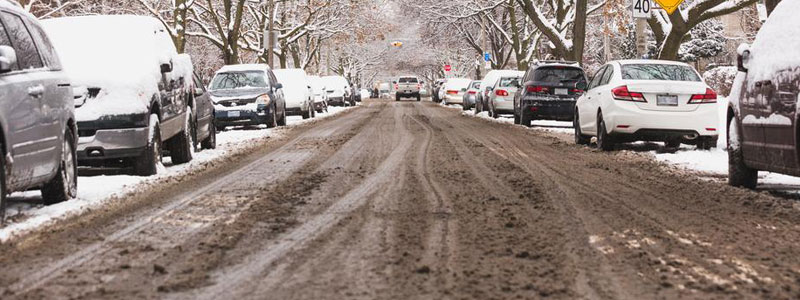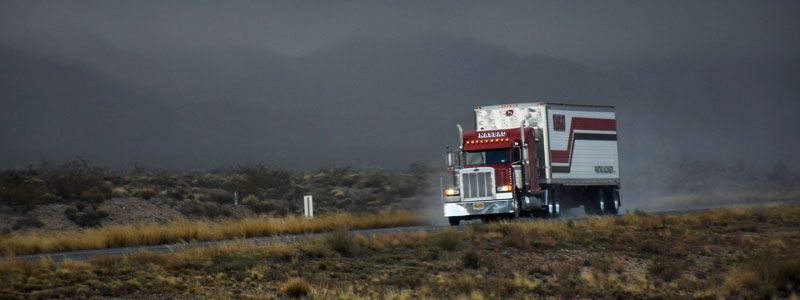How to Share the Road with a Semi Truck in Unpredictable Weather
February weather is rarely predictable. Not even groundhogs can shed light on whether or not we’ll suffer six more weeks of winter or welcome an early spring. Indiana is known for its often-shifting weather forecasts. Hoosiers are used to starting the day with some rain, having lunch in the snow, and heading home from work […]

February 16, 2018

February weather is rarely predictable. Not even groundhogs can shed light on whether or not we’ll suffer six more weeks of winter or welcome an early spring.
Indiana is known for its often-shifting weather forecasts. Hoosiers are used to starting the day with some rain, having lunch in the snow, and heading home from work in the balmy sunshine. The weather can change in a blink of an eye here, and most of us have just gotten used to it over the years.
But it can be difficult to operate a vehicle in rapidly changing weather, particularly next to a semi truck on one of Indiana’s many major highways. Here’s how to share the road with a semi truck when the weather is anything but ordinary.
From Sun to Rain

If you happen to enjoy a rare day of sunshine in February in Indiana, it’s sad to see the rainclouds come. Most Hoosier drivers know how to drive in the rain; of our crazy weather events, it’s one of the most benign. But it’s important to adjust your driving habits even further to accommodate any semi trucks that may be riding alongside of you.
The most important thing you can do if you’re behind a semi truck is to increase your following distance. Here’s why:
First, rain may spray back from the truck’s tires and hit your windshield, obscuring your vision. Increasing your following distance protects your ability to see and predict the semi truck’s move.
Second, semi trucks take longer to stop in the rain, and so do you. If the semi truck stops, you’ll want plenty of time to stop so you don’t crash into the truck accidentally.
Third, increasing your following distance keeps you out of the semi truck driver’s blind spot. It also allows you to see more of what’s ahead and not have your vision obscured by the truck’s cargo. If you’re able to see what’s coming up (for example, an intersection), you’ll be better able to predict the semi truck’s movements and anticipate when it will slow down or stop.
From Rain to Ice and Snow

We’ve already had a few days here in Indianapolis this winter where a couple days of heavy rain turned the roads into ice skating rinks after a sudden freeze. A drop in temperature overnight is bad enough — but what if you’re on the road while the rain turns to ice and snow?
If you’re traveling alongside a semi truck and the rainy weather starts to freeze, there are a few precautions you should take:
First, slow down, especially when turning or taking sharp curves. If you decide to pass a semi truck, make sure you don’t have to speed to get around the truck quickly. You’ll increase your risk of losing control of your vehicle if you accelerate or decelerate suddenly.
Next, increase your following distance in case the truck driver loses control of their vehicle. Staying behind the semi truck at a safe distance will also allow you to drive in the truck’s tire tracks.
Finally, be willing to adjust to the circumstances. Snow and ice will likely mean that you’ll be driving well below the speed limit. You may not be able to see the lines between the lanes, or one lane may be effectively closed due to a buildup of snow. Adjust to the flow of traffic in order to get home safely.
From Ice to Melting Snow

The sun may not return by the end of February, but if we’re lucky, temperatures will begin to warm up in anticipation of spring. Days or weeks of driving on icy roads will come to an end, and navigating slush and melting snow will take its place.
It’s important to remember that the roads may still be slippery despite the sunshine. If you’re sharing the slushy roads with a semi truck, make sure to follow these two tips:
First, don’t get over-confident. The sun is out, but speeding by a semi isn’t only dangerous when the weather is bad. Make sure you obey the speed limit regardless of the weather.
Second, don’t stay in a semi truck’s blind spot for long, even if you’re not passing. The blind spot on the truck’s right side is actually much longer and wider than the blind spot on its left. It’s best to either slow down and stay behind the semi or to pass on the left as quickly as possible without speeding.
From Sun to Storm

Indiana storms can be quite intense. We’ve already covered what to do in the rain, snow, and ice, but one thing that often accompanies storms of all kinds is wind.
Wind can make semi trucks difficult to control, especially if the truck is empty of any cargo. In stormy conditions, watch any semi trucks near you to see if they’re struggling to stay in their lanes. If they are, avoid passing them unless absolutely necessary. You don’t want to risk the semi truck drifting into your vehicle.
Be sure also to increase your following distance, especially if the semi truck is turning or taking a sharp curve. The semi truck may overturn if the winds are fierce and the turn is sharp.
Help from an Indiana Truck Accident Attorney
With Indiana’s ever-changing weather, it’s no wonder that semi trucks accidents continue to occur on our major roads and highways. If you’ve been injured in a truck accident, Hensley Legal Group can help. Call us today or contact us online for a free consultation.